• Delineating bedrock topography, rippability, thickness of overburden, slip zones and their quality.
• Mapping the thickness of subsea bottom layers, morphology of bedrock in reservoirs and coastal environments for maritime structures
• Studying pre and post dredging of subsea .
• 48 and 24 Channel Signal Enhancement Seismographs.
• High resolution under water CHIRP sub-bottom seismic reflection system.
• Electrical Resistivity Imaging System.
• Ground Penetrating Radar.
• Compressional and shear wave cross-hole system, with sparker source and Deviation Probe
Software:
• VISUAL SUN_T software for reflection data analysis
• RESIS 2D software for Electrical Imaging data analysis
• SeisImager/SW software for Surface wave data analysis
• Reflex 2D
• Surfseis for MASW data analysis
• Geotom for Seismic Tomography data analysis




Highlights and Achievements
3.1 Client Sponsored:
Specific studies under taken in the area of work for different projects are given below in a nutshell
- Bedrock delineation: Tarapur, Karwar, Sardar Sarovar, Omkareshwar, Project Victor, Rail-cum-Road bridge at Jogighopa, Amochu HEP. Punatsangchhu HEP, RKHEP
- Rock Quality for water conductor system: Kalinadi, Kasheli, Pench, Koyna, Loharinag-Pala, Tapovan-Vishnugad, Lata Tapovan
- Dynamic Young’s and Shear Moduli: Kota, Kudankulam, Tarapur, Kaiga
- Cross-hole seismic tests: Kaiga, Tarapur, RKHEP
- Buried river course : Narayanpur, Gosikhurd, Sipu
- Liquefaction potential of soil : Kayamkulam, Subansiri
- Earth resistivity for Earthing systems: Kaiga, Kakrapar, Rajashtan Atomic Power Project, Vishunagda Pipalkoti HEP.
- In-situ density and porosity: Vindhyachal, Kayamkulam, Mangalore Super Thermal Power Project
- Sub-bottom stratigraphy in sea: Jawaharlal Nehru Port, Tuticorin, Ennore, Maroli, Dabhol, Visakhapatnam, Tarapur APS
- Health of old masonry and concrete dam: Murbadi, Rihand, Vijayawada, Dimbhe, Manikdoh
- Efficacy of grouting: Salal, Dudhganga, Rihand
- Source and path of seepage: Pench, Jakham, Dudhganga, Pawana, Talabira, Nangal Hydal Channel
- Leakage through canals: Bhind, Kakrapar, Indira Nehar Pariyojna, Nangal Hydal Channel
- Reservoir compentency: Yeshwantsagar, Yavatmal
- Archeological Studies: Kelshi, Rakhigiri
3.2 Other Assignments
Other assignments include following:
1. Monograph on “Seismic Refraction Methods for Engineering Applications”, 2008
2. Controlling Seepage Through Hydraulic Structures 2015
3. Dam Safety and Rehabilitation, 2015.
4. Contribution of CWPRS for hydropower development-hydraulic and structural aspects, 2015.
4.0 List of Clientele
BARC, JNPT, BBMB, DVC, Indian Navy, NPCIL, NTPC, WAPCOS, THDC.
4.0 Technical Breakthrough
Achievements:
- Found entrance shaft of buried hanger at Dakshin Gangotri, Antartica
- Found buried dredger at downstream of Kosi Barrage
- Mapped artifacts at Rakhigari, Haryana
- Found missing copper strip below construction joint at Prakasham Barrage, A.P
- Traced Ghosikhurd buried channel
ISOTOPE HYDROLOGY DIVISION
Isotope Hydrology, the erstwhile Tracer Hydrology Division was established in the year 1979, under the UNDP aided project for Applied Earth Sciences Division. In the initial phase of its functioning, this division had contributed to water resources sector through radio isotope studies. With the application of state of art equipment and techniques this division has also built up the capability for providing rapid, economical and more accurate solutions to problems related to various civil engineering structures.
Major Research Activities
- Foundation studies for Dams, their allied structures and Power Plants
- Insitu electrical resistivity, density, porosity, P and S wave velocities are measured to assess the strength of the subsurface formations
- Studies related to health of Hydraulic Structures
- Insitu density, porosity, P and S wave velocities are measured to diagnose the health of the structures and assess the post remedial efficacy.
- Detection of seepage in Hydraulic Structures ( Dams and Canals)
- Insitu density, porosity, variations in borehole diameter are measured and tracer techniques are applied for detection of seepage zone.
These studies are conducted using the following techniques.
- Borehole Logging
- Tracer studies
METHODOLOGY
Bore-Hole Logging Techniques : Typical Borehole Log
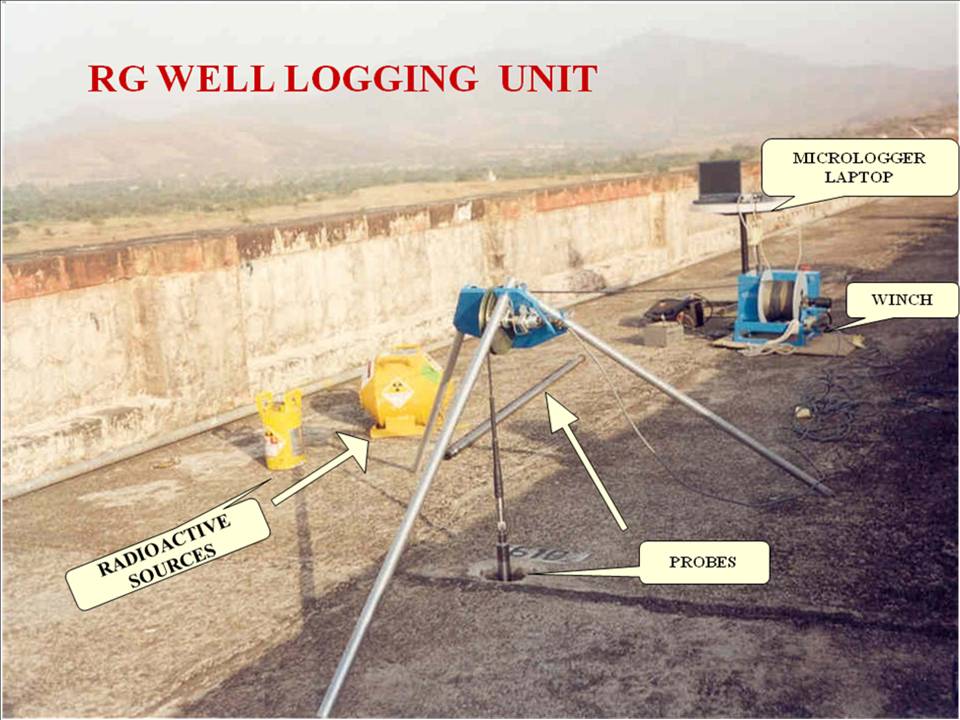
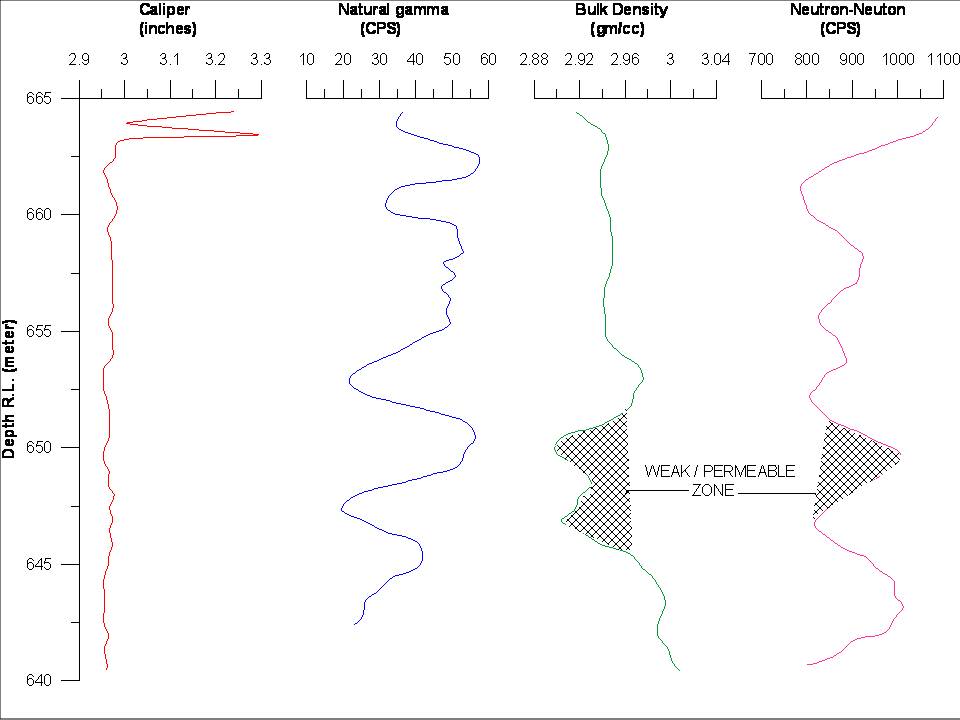
Borehole logging includes techniques of lowering sensing devices in boreholes and recording different physical parameters, which may be interpreted in terms of characteristics of subsurface formation. It provides a continuous quantitative set of data of the insitu physical properties of the geological material and man-made structures surrounding the borehole. Different logging techniques include:
-
Electrical Logging : E-log measures the electrical resistivity of the formations surrounding the borehole which is useful in identification of geology.
-
Nuclear Logging : Comprises ‘‘ Gamma-gamma/ density log’ and ‘Neutron-neutron log’ for determining in-situ bulk density and hydrogen content/porosity respectively.
-
Acoustic logging : Sonic Log is used for determining P (compressional) and S (shear wave) wave(s) velocities and computing the mechanical properties of the formation like Poisson’s ratio, dynamic modulus of elasticity and Shear modulus. These parameters are used in assessing the strength of the foundation and serve as input parameters in assessing the health of hydraulic structures
-
Calliper Logging : Caliper logs measure the variation in borehole diameter which help in identifying the location of cavities and fractures; also used to correlate with the other logs.
Tracer Techniques :
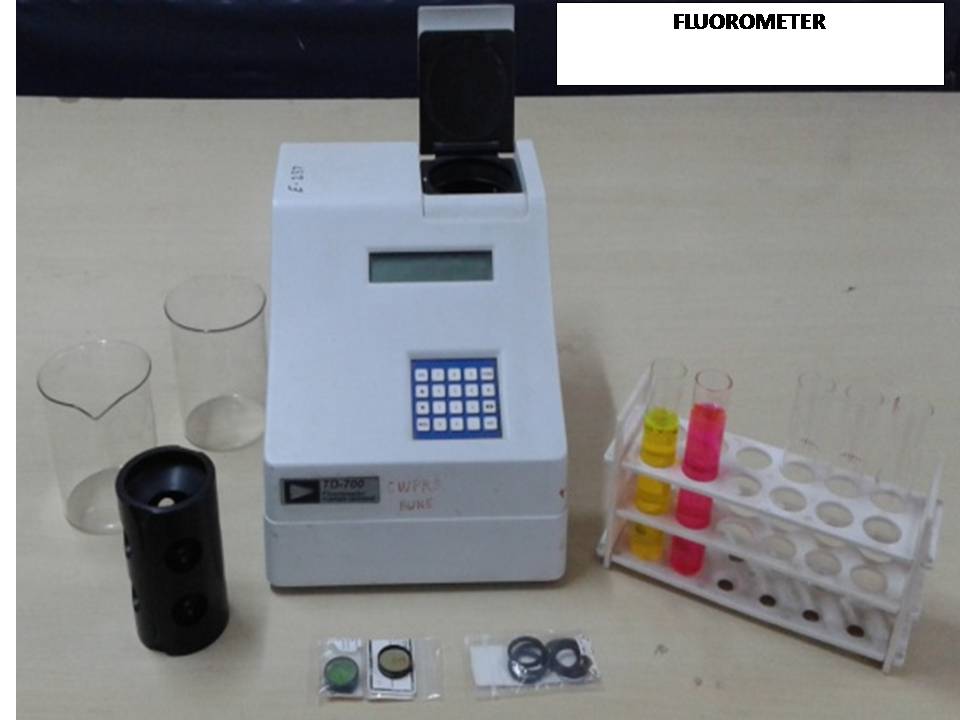
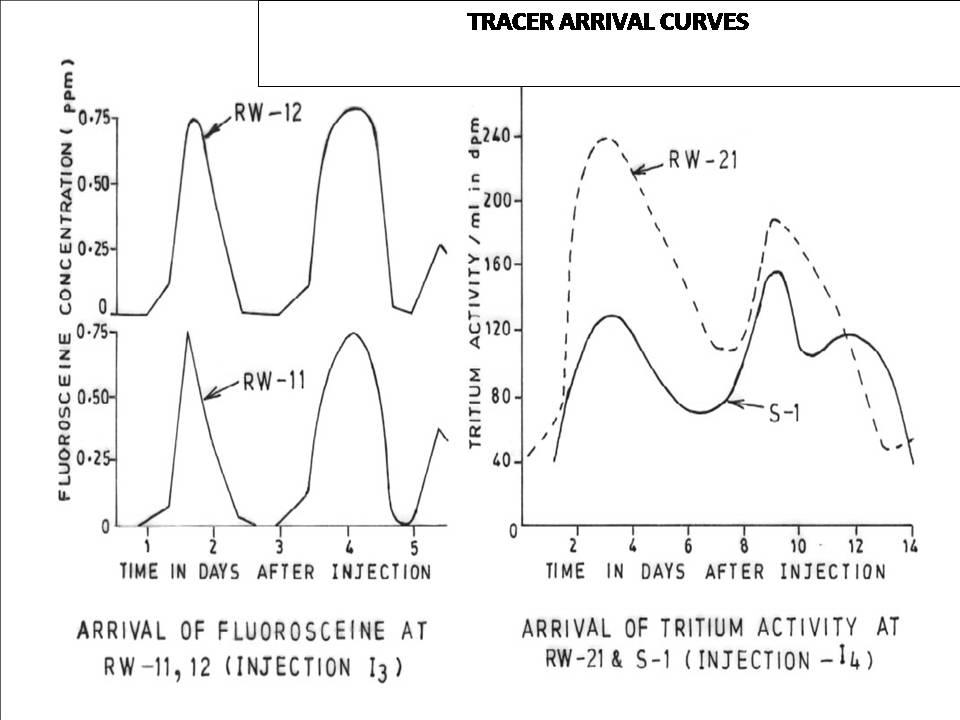
Tracer Technique uses the concept of water/dye tracing method by injecting tracer(s) (Sodium fluoroscein dye, Rhodamine-B) in the dam, reservoir or canal and monitoring the dilution of tracers in the areas of leakage, thereby enabling the delineation of path of seepage and identification of its source. The tracer techniques can be employed by utilizing two methods viz. Single Well or Point Dilution Technique and Multi-well Techniques. It is also an efficient technique to determine direction of flow and seepage velocity through porous medium. Tracer concentration is measured using a Laboratory Fluorometer. These studies are also conducted to assess the efficiency of remedial measures.
MAJOR PROJECTS INVESTIGATED
Health of Hydraulic Structures :
- Concrete dam: Dimbhe, Kolkewadi,Indira Sagar, Koyna, Omkareshwar, Popatkheda
- Earthen dam: Nagarjunasagar,Upper Manner, Bhama–Askhed, Sipu, Salauli
- Masonry dam: Pawna, Dudhganga, Erai,Kuttiadi, Barvi, Khadakpurna, warna, Bhatsa
- Rockfill dam: Salal H.E, Sardar Sarovar, Arkavathy
- Canals Indira Gandhi Main Canal, Kakrapar, Panchakula
Foundation studies:
- Kaiga, Kakrapar and Rajasthan Atomic Power Project
- Kayamkulam, Mangalore, Maithon, Vindhyachal Thermal Power Plants
- Shivasamudram, Ghatghar hydroelectric Power Project
- Tuticorin port, Bridge at Kalyani
- Vibration Technology Division
Vibration Technology Division
Vibration Technology Division is engaged in activities for various client sponsored river valley projects as well as basic research in the field of measurement of Vibration and sound level, Non-destructive testing of concrete and masonry structures and Controlled Blast studies comprising of conducting trial blast for safe charge determination, in-situ monitoring of both surface and underwater blasting, interpretation and analysis of in-situ test data to determine site specific attenuation relation for designing parameters for controlled blasting based on guidelines provided in both National and International Standards.
1. Vibration and sound level studies:
a) Electro Dynamic Vibration Shaker System is used to evaluate dynamic characteristics like natural frequency, damping and mode shapes of structures and power transmission network equipment both in laboratory and in-situ environment.
b) Monitoring structural vibrations for assessing the safety of old dams, power house, bridges etc using data acquisition system.


Vibration monitoring System
Electro Dynamic Vibration Shaker System
Vibration measurement at Turbine Pit and Turbine Guide Bearing for Kadana Dam, Gujarat
Vibration and Sound level measurement at pumping station of Saurashtra Branch canal, Gujarat
Important studies carried out:
Farakka Barrage, West Bengal; NHDC Khandwa, Madhya Pradesh; Saurashtra Branch Canal, Gujarat, Umiam Dam Meghalaya, Kadana H.E.Project, Gujarat, Dudhganga H.E.Project, Maharashtra, Koyna HEP, Stage-III, Maharashtra etc..
2. Non-destructive Testing (NDT):
a) Ultrasonic Pulse Transmission Technique is a non destructive testing method to find out weak zones such as honey combing, voids, cracks, etc. in a concrete structure and assessing in-situ quality of material for different massive engineering structures like concrete Turbo Generator foundation of Thermal and Hydro Power Stations, Chimney, Aqueduct, concrete/masonry Dam, etc. as per BIS: 13311 (Part 1).
Portable Ultrasonic Digital Indicating Tester (PUNDIT)

Typical Velocity contours depicting the quality of the in-situ concrete of Columns of Rourkela Steel Plant , Odisha
Important studies carried out:
More than 50 T.G. foundations of Thermal Power Stations in Maharashtra namely, Khaperkheda, Bhusawal, Chandrapur, Paras, Parli, Koradi, Nashik, etc., Vijayawada Andhra Pradesh, Birsinghpur, Madhya Pradesh. Sardar Sarovar Dam, Gujarat; Rourkela Steel Plant, Upper Kolab, Project,Odisha etc.
b) Sonic Pulse Transmission Technique is a non-destructive testing method to find out weak zones comprising of voids, cracks, etc. in concrete and masonry structures like dams, Aqueduct, Canals, etc. and thereby checking homogeneity of the material forming the structure. Since, ultrasonic pulse transmission technique has got limitation of penetration depth up to 5 meter, sonic pulse transmission technique is adopted for depth exceeding 5 meter.
1) 24 Channel Signal Enhancement System 2) NDT by sonic transmission technique at Ujani Dam, Maharashtra <o:p>

 NDT by sonic transmission technique at Vakkileru Aqueduct
NDT by sonic transmission technique at Vakkileru Aqueduct
NDT by sonic transmission
technique at Sardar
Sarovar Dam, Gujarat
Important studies carried out: Very old aqueducts (about 140 year old) on the Kurnool Cuddapah canal (e.g. Hundri, Alluru, Tarigopula, Vakkileru aqueducts) in Andhra Pradesh and several dams in Maharashtra namely Khandala, Lower Terana, Ujani and Ozhar pickup wier, Sardar Sarovar Dam, Gujarat; and small Dams on Tulsi, Powai, Vihar lakes, Maharashtra.
c) Estimation of Dynamic properties of material by Resonance Frequency Test system:
Estimating fundamental frequencies of rock samples in longitudinal and torsional modes of vibrations. Determination of dynamic elastic properties like Young’s modulus of elasticity (E), Modulus of Rigidity (G) and Poisson’s Ratio (µ) based on fundamental frequencies of vibrations in longitudinal and torsional modes of vibrations as per guidelines of ASTM C 215 - 02.

Test setup for determination of resonant frequency in longitudinal and torsional mode of vibrations
Important studies carried out: Rajasthan Atomic Power Plant; Fugro Geotech Mumbai, Maharashtra etc.
d) Impact Echo test is a method for non-destructive evaluation of concrete and masonry, based on the use of impact generated stress (sound) waves that propagate through the structure and are reflected by internal flaws and external surfaces. Impact Echo technique can be used to determine thickness in concrete slabs and plates, as per ASTM Standard C 1383 - 98a. It can also be used to determine the location and extent of flaws such as cracks, delaminations, voids, honeycombing and debonding in plain, reinforced and post-tensioned concrete structures.
Impact Echo test system with waveform for determination of p-wave velocity
e) Schmidt Rebound Hammer test is a non-destructive testing method of concrete which provide a convenient and rapid indication of the compressive strength of the concrete. It is used for surface hardness testing of concrete structure as per BIS: 13311 (Part 2).

 NDT by Schmidt Rebound Hammer at Bhatghar HEP, Maharashtra
NDT by Schmidt Rebound Hammer at Bhatghar HEP, Maharashtra
 Schmidt Rebound Hammer
Schmidt Rebound Hammer
3. Controlled Blasting studies are carried out both for surface, underground and underwater excavation of rock, in order to minimize the unwanted effects of uncontrolled blasting such as ground vibration, air blast, fly rocks, over-breakage and propagation of cracks at the perimeter. Many a time blasting activities are carried out near residential structures, structures of archeological importance, Old Dams for which a very conservative approach is adopted while designing the blasting pattern in order to safe guard these structures from the adverse effects of blast vibrations based on IS 14881:2001 guide lines. A site specific attenuation relation is developed after conducting few trial blasts at site to understand the attenuation characteristics of the ground vibrations and safe charge weight per delay is estimated using the relation. During actual blasting, continuous monitoring of the blast vibration is further carried out by using three component engineering seismographs and report is generated after analysis and interpretation of test data.

1) Three component engineering seismograph model Instantel MiniMate
Vibration monitoring at a Historical Monument in Mumbai, Maharashtra
Important studies carried out:
Expansion of navigational channel of JNPT, Mumbai, Dismantling of old weir on the upstream of New Mahanadi Barrage, Odisha, Rock dredging for Mumbai Port Trust; Deepening of Mithi river bed, Mumbai; Excavation of rock and RC concrete for strengthening of overflow section of Koyna dam, Maharashtra; Controlled blast studies for Kakrapara Atomic Power Station, Gujarat; Prototype Fast Breeder Reactor (PFBR) Kalpakkam, Tamilnadu and Tarapur Aromic Power Projects, Maharashtra
ENGINEERING SEISMOLOGY
This Division has been actively engaged in providing project specific consultancy in the fields of seismology and earthquake engineering for several years. The main areas of activities of the division comprise of Microearthquke studies, Strong Motion studies and estimation of site-specific seismic design parameters.
I. Microearthquake studies:
A seismic network of Microearthquake recorders around the project site is established with following objectives
• To determine location and magnitude of the local earthquakes
• To investigate aftershocks and swarm activity
• To delineate active seismic zone
• To map the local seismicity of the area
• To determine the source parameters of the earthquake
Typical Seismological Observatory for field study
 |
 |
| Seismological Observatory |
Internal set up for observatory
|
II. Strong motion studies:
A network of digital Strong Motion Accelerographs is established within the dam body and at far field with following objectives
• To study characteristics of strong earthquake ground motion for arriving at more accurate and realistic estimation of site specific design ground motion for important projects
• To study structural response of dams to actual earthquakes
• To estimate seismic source parameters
III . Estimation of site-specific seismic design parameters:
After studying the seismic environment which includes regional geology, tectonic processes, seismic history, locations and geometries of earthquake sources, and the type of faulting, site specific seismic design parameters such as Acceleration time history, Design Response spectra, Strong motion duration etc. are estimated using deterministic and probabilistic seismic hazard analysis approaches.
 |
|
| Major tectonic features in the study region |
|
 |
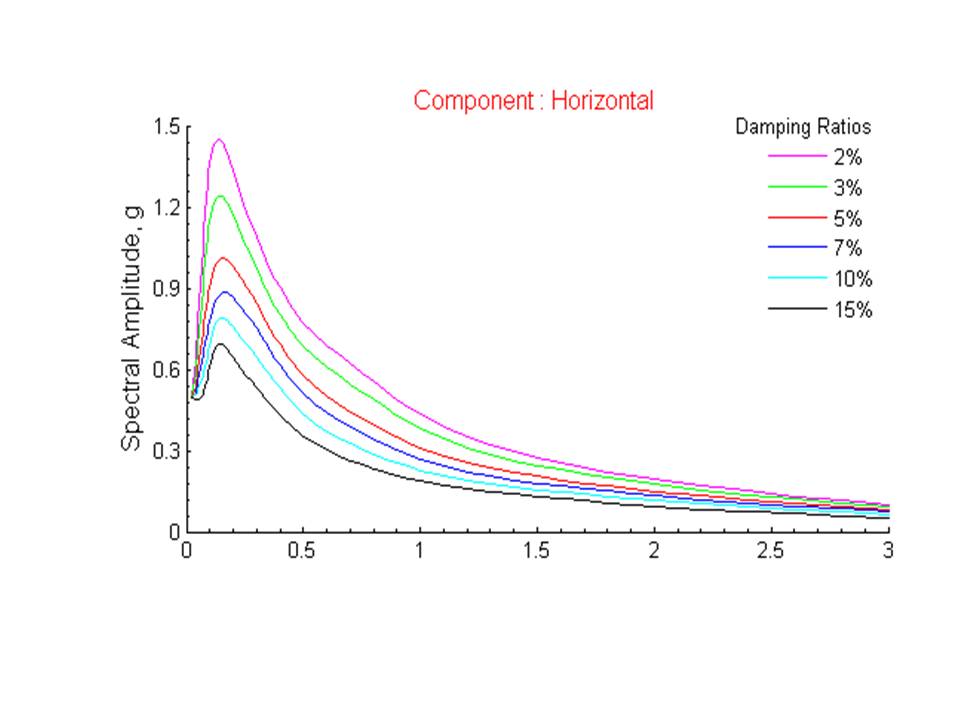 |
|
Acceleration time history.
|
Design response spectra for different damping ratios. |
FACILITIES:
Well equipped instruments like Earthquake recorders with Broadband Seismometer and Short Period Seismometer to study the local seismicity of the project area. Strong motion accelerographs to monitor the structural response of the dam body during an earthquake.
Equipment and Software for Microearthquake & Strong Motion Studies:
 |
 |
| Software: SCREAM, Seisan, GeoDAS |
Software: GeoDAS, ART |
SIGNIFICANT PROJECTS:
Seismic Hazard Assessment of North and North East India under DRIP
Estimation of Site-Specific Seismic Design Parameters for Pancheshwar Multipurpose Project, Nepal/India.
Estimation of Site-Specific Seismic Design Parameters for Tlawng HE Project, Mizoram.
Estimation of Site-Specific Seismic Design Parameters Study for Naitwar Mori Hydro Electric Project, Uttarakhand.
Estimation of Site-Specific Seismic Design Parameters Study for Goriganga IIIA Hydro Electric Project, Uttarakhand.
Seismological studies at Punatsangchhu - I H.E. Project, Bhutan
Seismological studies at Punatsangchhu - II H.E. Project, Bhutan
Seismological studies for Pancheshwar Multipurpose Project, India-Nepal
Microearthquake Studies for Sapta Kosi Sun Kosi Multipurpose Project, Nepal
Microearthquake Studies for Kuri- Gongri H.E. Project, Bhutan
Microearthquake Studies for Tlawng H. E. Project, Mizoram
Microearthquake Studies for Sawalkote H.E. Project, J&K
Microearthquake Studies for Kirthai H.E. Project, J&K
ESTEEMED CLIENTELE
Central Water Commission (CWC)
Pancheshwar Development Authority (PDA), Nepal
M/s WAPCOS Limited
Nepal-India Joint Project Office, Sapta Kosi Sun Kosi Investigation (JPO-SKSKI)
National Hydroelectric Power Corporation (NHPC)
Dam Safety Organization (DSO), Nasik
Jammu & Kashmir Power Development Corporation (JKPDC), J&K
Narmada Hydro Electric Development Corporation (NHDC)
Kanher Canal Sub-Division, Irrigation Department, Maharashtra